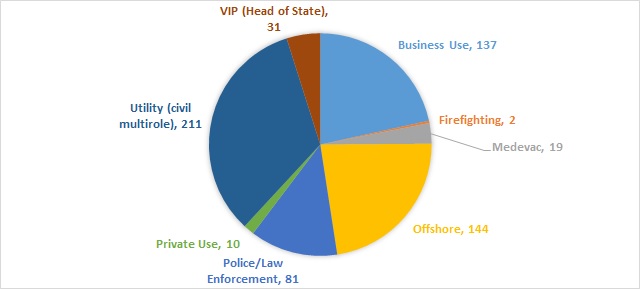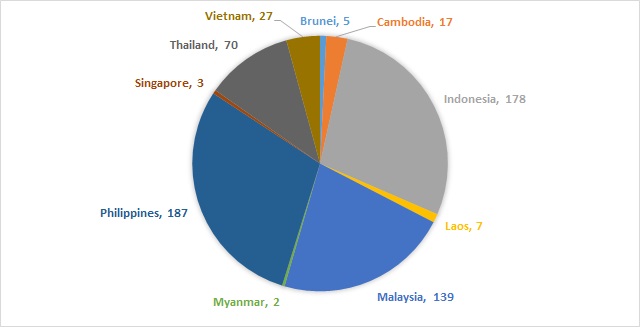Helicopter makers are looking for new opportunities in Southeast Asia amid weakness in the pivotal offshore oil and resources sector.
Passengers landing at Changi International Airport in 2015 were treated to a view highlighting the challenges facing the big helicopter manufacturers in Southeast Asia. Out in the Johore Strait between the city state and Malaysia, sat a long row of idle oil rigs, helipads empty. The rigs are a potent symbol of the how the oil price crash in the last 24 months has utterly changed the region’s helicopter market.
Manufacturers tend to put a brave face on things and like to discuss opportunities in areas like emergency medical services (
Flightglobal’s Fleets Analyzer lists the countries of the Association of Southeast Asian Nations (ASEAN) as having an in-service civilian/parapublic helicopter fleet of approximately 635 aircraft. There are firm orders for 56 additional helicopters, and 35 helicopters in storage. Of the region’s in-service fleet, 144 serve in the specialised offshore/oil & gas mission. There are also 137 for business use, 31
ASEAN civilian/parapublic helicopter fleet by usage

Flightglobal Fleets Analyzer
A research report from Rigzone, a trade publisher for the oil and gas sector, says 2015 was a year that the oil and gas industry would like to forget, but that this will be hard because 2016 could be even worse. It notes the price of Brent crude fell 43% in 2015, and utilisation for all types of rigs fell sharply in 2015. “In summary, 2016 is likely to be a survival year for those companies that operate in the offshore rig arena,” it says.
Fewer operational rigs and tough times at oil companies are anathema to the helicopter operators tasked with transporting personnel.
“We continue to monitor the situation closely,” says Christophe Nurit, Sikorsky’s regional sales director for Asia. “Sikorsky and every other helicopter OEM selling helicopters for offshore oil transportation are affected by the low price of oil and the increase in idle aircraft. Yet even with some aircraft removed from service, the percentage of flight hours for the S-92 helicopter fleet operating in this segment has been rising in the low single digits year over year, which we view as an encouraging sign and strong operator confidence in the aircraft.”
The issue for helicopter makers is that the energy sector’s collapse coincides with the introduction of advanced helicopters designed when oil prices were over $100. High oil prices justified oil platforms in deep waters, hundreds of kilometres from shore. Helicopters such as the Airbus Helicopters H175, Bell 525 Relentless, and AgustaWestland AW189 were designed for this mission – and have seen the main justification for their existence disappear virtually overnight.
Philippe Monteux, senior vice president of Airbus Helicopters in the region, is gloomy about the region’s offshore market.
“[For 2015] we had zero bookings in this region for the oil and gas market,” he says. “Not only the H225, but also the H175. We booked some helicopters through big operators such as Bond or
Fleets Analyzer shows the biggest operator of offshore helicopters in the region is Malaysia’s Weststar Aviation with 23 helicopters – 20 AgustaWestland AW139s, one AW189, and two Sikorsky S-76s. Other big regional operators include another Malaysian outfit, MHS Aviation with 18 helicopters; Indonesia’s Pelita Air Services, with 14; and Indonesia’s Travira Air, also with 14.
Sikorsky is the lead player in the ASEAN offshore market, with 45 aircraft in service. These comprise 40 S-76s, four S-92s, and a single S-61. It is closely followed by AgustaWestland, which has 43 offshore helicopters in the region, Airbus Helicopters with 33, and Bell Helicopter with 20.
One long-time industry observer says he has never seen the offshore helicopter market this bad. Manufacturers say operators have reduced utilisation rates by 20-30%, but he says the true number is probably more like a 50% reduction from early 2015. Apparently, helicopter lessors have slashed lease rates to keep their fleet with operators and in service. “I don’t understand how they can be profitable,” he says.
Nonetheless, there is still some positive activity around the sector. In October 2015, simulator firm
“There is no question that current market conditions have forced offshore oil and gas customers to make major fleet and aircrew staffing adjustments,” says
“However, there is still a sizeable installed base of helicopters in the region used for offshore oil rig and search and rescue support missions, and that installed base creates training requirements. So even though the acquisition of new aircraft has slowed, aircrews operating existing fleets continue to utilise our simulation-based training centres as a cost-effective way for them to stay current.”
In addition, Singapore airshow organiser Experia Events recently launched a specialised air show for the commercial helicopter sector. The first iteration of Rotorcraft Asia will be held from 18-20 April 2017. The events company already has letters of intent from six companies to participate: Airbus Helicopters, Bell Helicopter, Honeywell, Safran Turbomeca, and StandardAero.
ASEAN civilian/parapublic helicopter fleet by country

Flightglobal Fleets Analyzer
Still, helicopter executives Flightglobal spoke with are optimistic about other sectors in the Southeast Asian market, namely
Fleets Analyzer shows just 31 helicopters as dedicated specifically for
A number of helicopters listed as utility types are also likely used to carry rich individuals, but Southeast Asia can be a very challenging place for a private operator seeking to take full advantage of a helicopter’s flexibility. Airbus Helicopters, for example, recently treated journalists to a media flight from Seletar airport aboard an H145 T2. For a 10min ride around the airport, the passengers had to go through an airport-style screening process, adding time and hassle. The aircraft was not allowed to depart directly from its parking spot on the apron, but was obliged to hover-taxi feet above the ground, and then takeoff along the runway. Regulations are similar in Thailand.
CM Hwang, managing partner of leasing startup Aeroinfinity and a former executive at Bell Helicopter, says that a helicopter onboard a super yacht cannot take off from the ship in Singapore waters and fly to a local airport. Instead, the yacht must be in international waters for the helicopter to fly into Singapore.
Such restrictions abound across the region. Malaysia is commonly viewed as being among the most helicopter-friendly countries, but countries such as Singapore, Thailand and Vietnam are among the more restrictive.
Growth in the
“A helicopter that has to wait on the ground for clearance is not an
Nonetheless, Rehman is optimistic about opportunities for
Irrespective of the challenges around the oil & gas,
Southeast Asia has come to a crossroads in the use of helicopters. Traditionally, the region's oil and resources sectors have driven a large portion of the demand for rotorcraft. Given changes in these key markets, however, it is incumbent on manufacturers to further diversify into civilian and parapublic areas. To a great degree this will depend on their ability to educate the region’s governments about the broader benefits of civilian helicopter usage.
Get all the latest news, analysis and opinions from Singapore Airshow on our dedicated show page
Source: FlightGlobal.com























